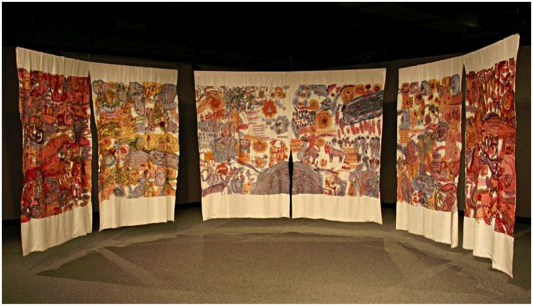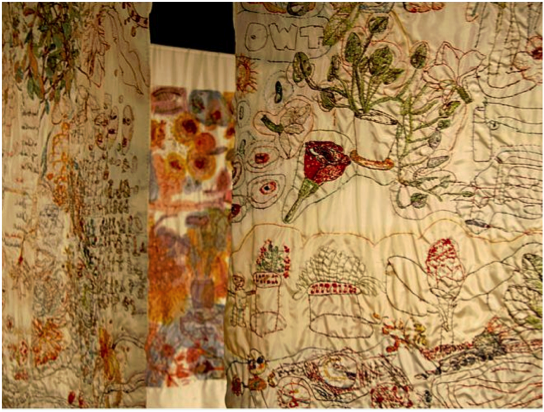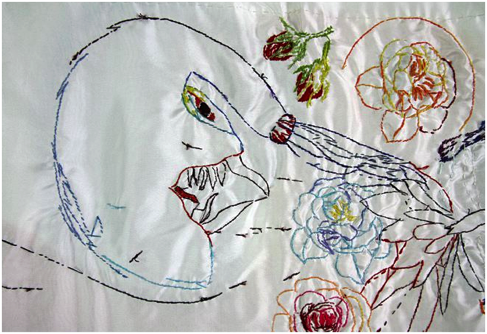March 14th 2012
By Kevin Burns
 The visual artist Anna Torma uses the word Bagatelle in inverted commas because she says she has borrowed the word from the world of music. “It’s usually used to describe small things, not a full symphony.” An exhibition featuring her work, titled “Bagatelles” has been on display since fall, 2011 at the New Brunswick Museum in Saint John.
The visual artist Anna Torma uses the word Bagatelle in inverted commas because she says she has borrowed the word from the world of music. “It’s usually used to describe small things, not a full symphony.” An exhibition featuring her work, titled “Bagatelles” has been on display since fall, 2011 at the New Brunswick Museum in Saint John.
Entering a darkened gallery, visitors encounter six large hanging silks in the centre of the space. “This is art that moves gently with you,” she explains. As people move about the gallery their actions cause the hangings to dance delicately. “It is something you experience haptically and visually, not verbally. It is a kind of fantasy.”
Torma integrates both drawing and words in these large fabric works. Silk dominates the pieces that comprise “Bagatelles” because it is “one of the great human inventions from the natural world,” she explains. And she should know. As a child growing up in Tarnaörs, some 60 kilometres to the east of Budapest, she thought she might pursue a career in the natural sciences, perhaps even become a doctor. Instead, she followed her artistic instincts and, from 1974-79, studied at Budapest’s Hungarian University of Applied Arts, where she specialized in textile art and design. In 1988 she moved to Canada and set up a new home and studio in New Brunswick. “This was perhaps more a story of coincidence than a plan, as in everything in life,” she adds wistfully.

Torma situates her fabric art at the borderline of craft and the world of fine art. “Audiences know about fabric and textiles. It is a link to their clothing. The work of a needle and thread tell you about life on a small scale.” At the same time, she says there are great, culturally significant works of fabric art “that tell you much more about the way of life in that age centuries later.” She offers the examples of the great golden-threaded coronation robe commissioned by King Stephen and Queen Gisella in Hungary in 1031 now on permanent display at the Hungarian National Museum in Budapest. And she refers to the 70-metre, Bayeux Tapestry created in the same century and on display in the Musée de le Tapisserie de Bayeux in France.
The pieces that comprise “Bagatelles” she describes as narrative, whimsical, and complex, explaining that they are often autobiographical and draw on events from her own life. She describes them as an invitation to “find meaning in small things.” At first glance these finely crafted embroideries can appear to be drawings direct on the fabric but they are all stitched and embroidered. “If I want to draw on paper I will. These pieces are how I respond to the fabrics and to threads and to their aesthetics. I fall in love with a fabric: the shiny silk, so full of luxury. Silk is a wonderful human invention, filled with history.”
It is in the history of music, though, that the word bagatelle has had such resonance. The French composer François Couperin (1668 – 1733) is thought be the first to apply the word “bagatelle” when he used it to describe a collection of shorter keyboard works. Then came Beethoven (1770 – 1827), who used the label for a series of intense piano works which have been described as character portraits in the form of sound. Two generation later in Hungary, Franz Liszt applied the word to an 1885 piano piece: Bagatelle sans tonalité / Bagatelle ohne Tonart (S.216a), a chromatic work that he wrote as he was also working on his Mephisto Waltz compositions. Like these composers, Torma the visual artist is also drawing on a deep sense of culture, tradition, and history passed on and re-interpreted by one generation to the next as she captures fragments of life experience not note by note, but stitch by stitch.

As the New Brunswick exhibition winds down (it closes in April), Torma is busy preparing for a new exhibition in Newfoundland later this year. “There are un-sewn threads,” she explains with a smile. One of those significant threads will be her induction into the Royal Canadian Academy of Arts at its annual gathering, held this year in Newfoundland. Torma’s work, together with pieces from her fellow newly-minted Academicians and artists, will be included in a special exhibition at the Christina Parker Gallery in St. John’s.
Click here for Anna Torma’s website, including an extensive gallery of Bagatelle pieces.
Click here for more on the Royal Canadian Academy of Arts.
Anna Torma’s work will be featured during her induction to the Royal Canadian Academy of Arts at a combined summer exhibition at the Christina Parker Gallery in St. John’s, Newfoundland. Click here for more information.
